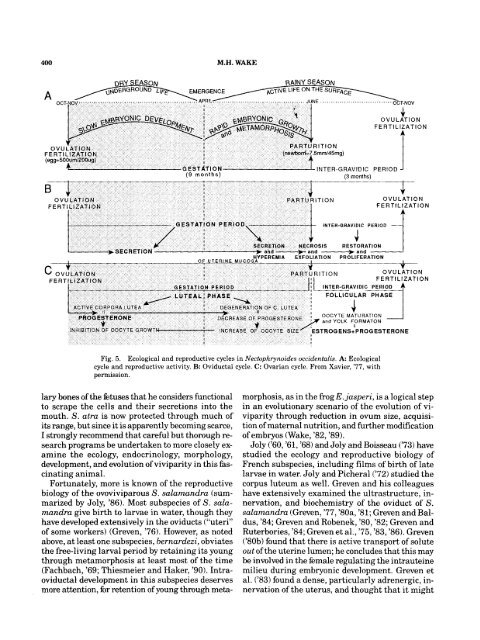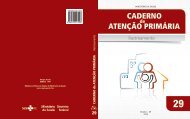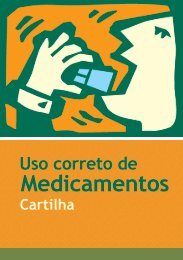Evolution of Oviductal Gestation in Amphibians
Evolution of Oviductal Gestation in Amphibians
Evolution of Oviductal Gestation in Amphibians
You also want an ePaper? Increase the reach of your titles
YUMPU automatically turns print PDFs into web optimized ePapers that Google loves.
400 M.H. WAKE<br />
..<br />
(9 months)<br />
md45mg)<br />
1<br />
.......... OCT-NOV<br />
4 0 V U L AT I0 N<br />
FERTlLlZATlC<br />
INTER-GRAVIDIC PERIOD<br />
(3 months)<br />
Fig. 5. Ecological and reproductive cycles <strong>in</strong> Nectophrynoides occidentulis. A Ecological<br />
cycle and reproductive activity. B: <strong>Oviductal</strong> cycle. C: Ovarian cycle. From Xavier, '77, with<br />
permission.<br />
lary bones <strong>of</strong> the fetuses that he considers functional<br />
to scrape the cells and their secretions <strong>in</strong>to the<br />
mouth. S. atra is now protected through much <strong>of</strong><br />
its range, but s<strong>in</strong>ce it is apparently becom<strong>in</strong>g scarce,<br />
I strongly recommend that careful but thorough re-<br />
search programs be undertaken to more closely ex-<br />
am<strong>in</strong>e the ecology, endocr<strong>in</strong>ology, morphology,<br />
development, and evolution <strong>of</strong> viviparity <strong>in</strong> this fas-<br />
c<strong>in</strong>at<strong>in</strong>g animal.<br />
Fortunately, more is known <strong>of</strong> the reproductive<br />
biology <strong>of</strong> the ovoviviparous S. salamandra (sum-<br />
marized by Joly, '86). Most subspecies <strong>of</strong> s. sala-<br />
mandra give birth to larvae <strong>in</strong> water, though they<br />
have developed extensively <strong>in</strong> the oviducts ("uteri"<br />
<strong>of</strong> some workers) (Greven, '76). However, as noted<br />
above, at least one subspecies, bernardezi, obviates<br />
the free-liv<strong>in</strong>g larval period by reta<strong>in</strong><strong>in</strong>g its young<br />
through metamorphosis at least most <strong>of</strong> the time<br />
(Fachbach, '69; Thiesmeier and Haker, '90). Intra-<br />
oviductal development <strong>in</strong> this subspecies deserves<br />
more attention, for retention <strong>of</strong> young through meta-<br />
morphosis, as <strong>in</strong> the frog E. jasperi, is a logical step<br />
<strong>in</strong> an evolutionary scenario <strong>of</strong> the evolution <strong>of</strong> vi-<br />
viparity through reduction <strong>in</strong> ovum size, acquisi-<br />
tion <strong>of</strong> maternal nutrition, and further modification<br />
<strong>of</strong> embryos (Wake, '82, '89).<br />
Joly ('60, '61, '68) and Joly and Boisseau ('73) have<br />
studied the ecology and reproductive biology <strong>of</strong><br />
French subspecies, <strong>in</strong>clud<strong>in</strong>g films <strong>of</strong> birth <strong>of</strong> late<br />
larvae <strong>in</strong> water. Joly and Picheral('72) studied the<br />
corpus luteum as well. Greven and his colleagues<br />
have extensively exam<strong>in</strong>ed the ultrastructure, <strong>in</strong>-<br />
nervation, and biochemistry <strong>of</strong> the oviduct <strong>of</strong> s.<br />
salamandra (Greven, '77, '80a, '81; Greven and Bal-<br />
dus, '84; Greven and Robenek, '80, '82; Greven and<br />
Ruterbories, '84; Greven et al., '75, '83, '86). Greven<br />
('Bob) found that there is active transport <strong>of</strong> solute<br />
out <strong>of</strong> the uter<strong>in</strong>e lumen; he concludes that this may<br />
be <strong>in</strong>volved <strong>in</strong> the female regulat<strong>in</strong>g the <strong>in</strong>traute<strong>in</strong>e<br />
milieu dur<strong>in</strong>g embryonic development. Greven et<br />
al. ('83) found a dense, particularly adrenergic, <strong>in</strong>-<br />
nervation <strong>of</strong> the uterus, and thought that it might






